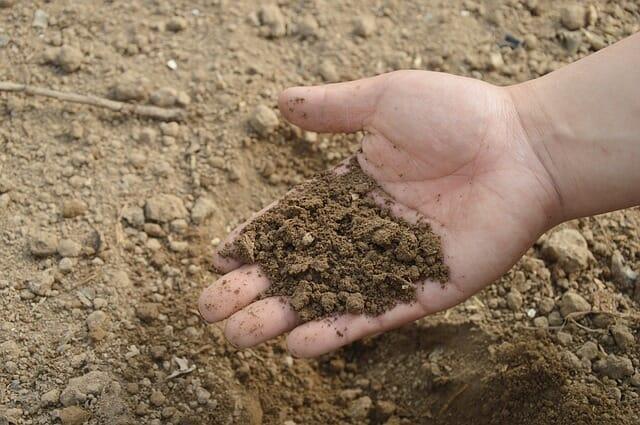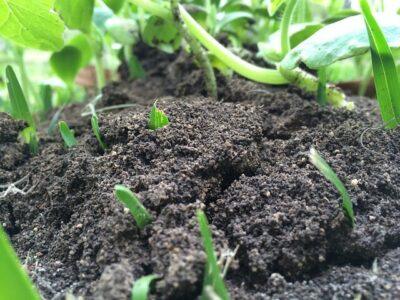
The creation of a healthy soil food web increases nutrient absorption and, in turn, solves many common soil problems.
The key to addressing common soil problems with balanced nutrients may be both easier and yet more complicated than you might think.
It’s not just about spraying the right fertilizer and watching it be miraculously sucked into your plants in the exact quantities they need. That’s because plants work in harmony with specific types of soil structures, microbe populations, and pH balances. So, the best thing you can do for your plants is to learn about creating healthy soil through mimicking natural processes in natural soil ecosystems and begin to think of your soil as just that: an ecosystem.
Treatment Of Nutrient Deficiencies
There are three main ways of treating soil nutrient deficiencies: increasing bio-availability/absorption of existing nutrients, adding non-harmful nutrient sources, and creating an efficient nutrient cycle.
Nutrient absorption can be increased through the creation of a healthy soil food web. You can achieve this by using composts, compost tea, chop and drop techniques, effective microorganisms, green manure and cover crops, and lots of mulch. With the healthy soil food, web microbes will predigest nutrients for plants, while helping to bind them in the soil within their bodies and within the rich, well-structured soil they help to create.
Efficient nutrient cycles are created by having a diversity of plants with different root depths and patterns. This is especially true for perennials (including trees). The process ensures nutrients are pulled from deeper in the soil while creating less root competition. Protecting your soil from erosion and nutrient leaching through mulch (4-6 inches) and/or cover crops is essential.
SeaMazing: The Low-Cost Way To Re-Mineralize Your Soil
It’s also important to test your soil, both nutrients and pH, ideally at a soil testing lab. You’ll most likely have to mail in samples following their collection instructions. This will then give you a picture of how to proceed.
Treatment Of Nutrient Oversupply
It can be easy to over-fertilize with concentrated chemical fertilizers like ammonium sulfate or sulfur-coated urea, for example. These fertilizers are damaging to soil ecosystems. Many fertilizers are directly toxic to soil organisms, particularly in high amounts. They react with other elements in the soil to create toxic substances such as sulfuric acid, hydrogen sulfide, and chlorine. Hydrogen ions released from some processes disrupt the soil’s nutrient-holding capacity. In addition, chemical fertilizers may increase mineral salts in the soil, stealing water from the plants.
It’s always best to go the slow-and-steady route when building your soil. You can use natural compounds that a healthy soil food web can break down and make available to the plants as they need them. It will work far better than trying to force feed your plants, which disrupts their ability to get what they need by themselves and creates more work for you.
The best way to treat oversupply is to stop fertilizing with fertilizers high in the nutrient in question. Furthermore, you need to re-balance the soil if the nutrient oversupply may have caused deficiencies in other nutrients.
Following are four common soil nutrients, along with how plants react if there is an under supply (deficiency) or oversupply.
Common Soil Problems (#1): Nitrogen Deficiency/Oversupply
Deficiency: Leaves turn pale green or yellow before finally dying, starting in older leaves, and overall plant growth slows.
Fertilizers: Seaweed, compost, compost teas, bone meal, and fertilizers containing natural sources of nitrates, ammonium or urea. Nitrogen “fixing” plants can help, since they have a symbiotic relationship with certain bacteria that pull, or fix nitrogen from the atmosphere. Plant things like peas, beans, honey locust and alder tree with your other plants.
Oversupply: Excess foliage growth, lack of flowering and fruiting, and stunted root growth. Browning of leaves and a buildup of mineral salts in the soil.
Common Soil Problems (#2): Potassium Deficiency/Oversupply
Deficiency: Leaf tips curl and leaves turn yellow between the veins before browning and dying. Root growth slows and plants have poor seed and fruit quality and quantity. Leaves may also develop brown or purple spots on the underside.
Fertilizers: Compost and compost teas, langbeinite, potassium sulfate, sylvinite, seaweed, greensand, rock minerals, and wood ash.
Oversupply: Calcium deficiency, low oxygen levels in soil, production of toxic compounds, loss of soil structure leading to compaction and poor water infiltration.
Common Soil Problems (#3): Phosphorous Deficiency/Oversupply

Efficient nutrient cycles are created by having a diversity of plants with different root depths and patterns.
Deficiency: Poor leaf, shoot and root growth; deep green, purple or red leaf color; delay in the maturity, including with fruit and seeds; poor nitrogen fixation in nitrogen-fixing plants.
Fertilizers: Compost and compost tea, mulch such as wood chips or straw, chicken manure, bone meal, rock phosphates (with no phosphoric acid added) and fish bone meal.
Oversupply: Yellowing of the leaves (especially just beyond veins), brown spotting, death of leaves, inhibition of beneficial fungi growth, decreased uptake of iron and manganese.
Common Soil Problems (#4): Sulfur Deficiency/Oversupply
Deficiency: Common in weathered soils and areas with heavy rainfall. Yellowing of leaves (especially younger leaves), dying leaf tips, stunted growth, high seedling mortality, few flowers. Similar to nitrogen deficiency, but with reddening of veins in young leaves.
Fertilizers: Compost and compost tea, langbeinite (as long as you need all of the nutrients contained), potassium sulfate (also includes potassium), gypsum and Epsom salt.
Oversupply: Rare, but causes acidity and deficiencies in selenium.
To recap: The most effective, low-labor and low-cost way to prevent and treat nutrient deficiencies and oversupply is to start conceptualizing your gardens or landscape as an ecosystem and to begin treating it as such.
Just as a forest has a constant layer of mulch, so, too, should your plants. Just as an oak savanna has healthy and diverse soil ecosystems supported by multiple species of plant roots at varying depths, so, too, should your landscape. We indeed can mimic natural ecosystems while still achieving our own aesthetic, using the plants we prefer while giving them what they need to (largely) take care of themselves.
What advice would you add on taking care of common soil problems and nutrient deficiencies in the garden? Share your tips in the comments section below:


























